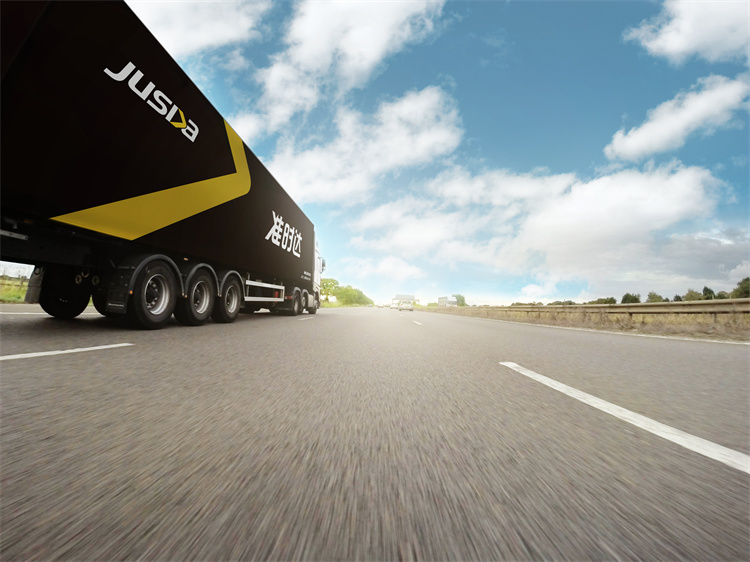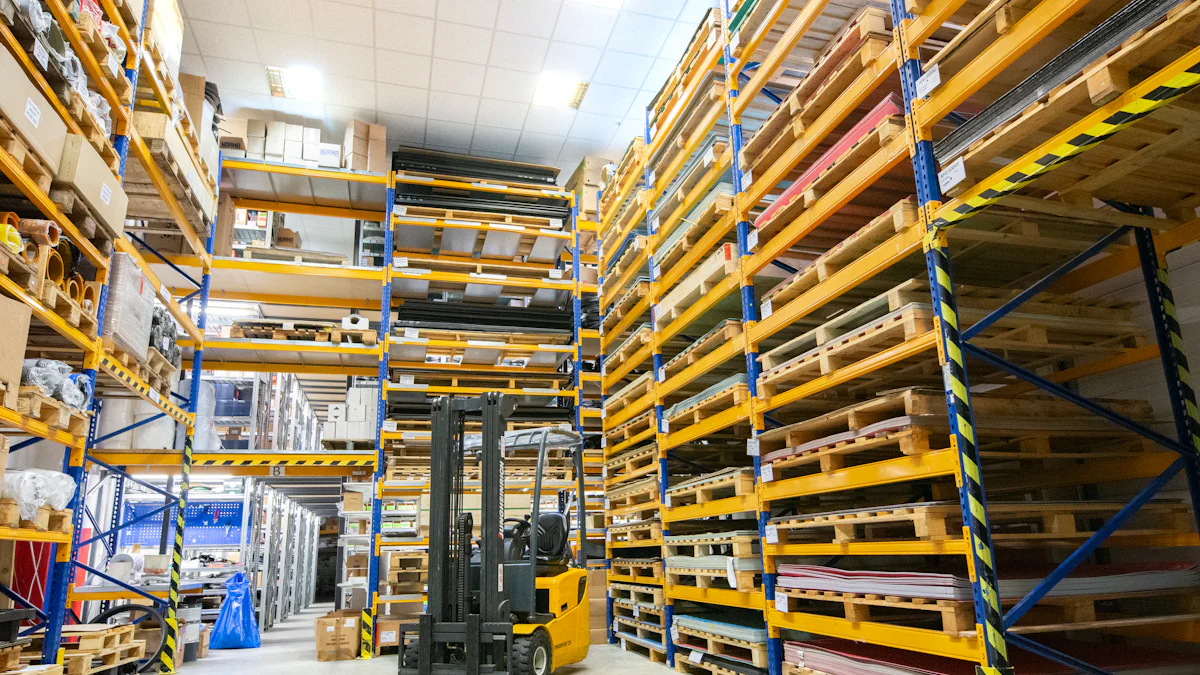Gross Vehicle Weight vs Curb Weight Explained for Warehouse Logistics

Understanding the difference between gross vehicle weight and curb weight is crucial in logistics. Curb weight refers to the vehicle's weight without passengers or cargo, while gross vehicle weight includes everything loaded. Mismanaging these weights can lead to safety risks, reduced fuel efficiency, and higher costs. JUSDA helps businesses optimize logistics, ensuring compliance and operational efficiency in your warehouse.
Key Takeaways
Curb weight is how much a vehicle weighs empty. This helps you figure out how much extra weight it can carry safely.
Gross vehicle weight is the total weight with everything inside. Knowing this is important to follow laws and avoid penalties.
Managing weight well makes vehicles work better and saves money. Check curb and gross weights often to keep vehicles safe and lasting longer.
What is Curb Weight?
Definition of Curb Weight
Curb weight refers to the total mass of a vehicle in its standard condition. It includes all necessary operating consumables, such as motor oil, brake fluid, coolant, and air conditioning refrigerant. A full tank of fuel is often part of this calculation. However, it excludes passengers and cargo. This measurement provides a baseline for understanding the vehicle's weight before any additional load is added.
Components of Curb Weight
Several factors contribute to curb weight. These include the vehicle's structural components, such as the chassis, body, and engine. Fluids like motor oil, transmission oil, and coolant are also part of the calculation. Additionally, the weight of standard equipment, such as tires and batteries, is included. A full fuel tank is another critical component. Together, these elements form the foundation of the vehicle's weight in its unloaded state.
Relevance of Curb Weight in Warehouse Operations
Understanding curb weight is essential for efficient warehouse logistics. It helps you determine how much additional weight a vehicle can safely carry. This knowledge ensures that you avoid overloading, which can lead to accidents or damage. Curb weight also plays a role in planning loading operations. By knowing the baseline weight, you can calculate the total vehicle weight after adding cargo. This ensures compliance with legal weight limits and protects your vehicles from unnecessary wear and tear. In warehouse logistics, managing curb weight effectively contributes to safety and operational efficiency.
What is Gross Vehicle Weight?

Definition of Gross Vehicle Weight
Gross vehicle weight refers to the total weight of a vehicle when fully loaded. This includes the vehicle's own weight, passengers, cargo, fuel, and any additional accessories. It represents the current weight of a vehicle at any given time. The term Gross Vehicle Weight Rating (GVWR) is often used to describe the maximum weight a vehicle can safely carry. This rating ensures the total weight of a vehicle does not exceed its design limits, preventing unsafe conditions or potential damage.
Components of Gross Vehicle Weight
Several elements contribute to the gross vehicle weight. These include:
The curb weight of the vehicle, which is its base weight with fluids and a full fuel tank.
The weight of passengers and their belongings.
The cargo being transported.
Any additional equipment or accessories added to the vehicle.
Each of these components adds to the total weight of a vehicle. Understanding these factors helps you manage loads effectively and avoid exceeding the vehicle's capacity.
How Gross Vehicle Weight is Calculated
You can calculate gross vehicle weight using simple methods. The most common formula is:
Another method involves adding the upper coupler vertical load or front tow bar coupler vertical load to the Gross Axle Weight Rating (GAWR). These calculations ensure you stay within the vehicle's safe operating limits. By knowing the gross vehicle mass, you can plan your logistics operations more efficiently and maintain safety standards.
Curb Weight vs. Gross Weight: Key Differences
Side-by-Side Comparison
Understanding the difference between curb weight and gross vehicle weight is essential for efficient logistics planning. These two terms represent distinct aspects of a vehicle's weight and serve different purposes in warehouse operations.
Aspect | Curb Weight | Gross Vehicle Weight |
|---|---|---|
Definition | Weight of the vehicle in its standard, unloaded state. | |
Includes | Fluids, full fuel tank, and standard equipment. | Curb weight, passengers, cargo, and additional loads. |
Purpose | Ensures compliance with road weight limits. | |
Logistics Application | Used for planning cargo loads. | Critical for adhering to legal weight restrictions. |
Curb weight vs gross vehicle weight highlights how these measurements impact logistics. Curb weight provides a baseline for determining how much cargo a vehicle can carry. Gross weight ensures the vehicle operates safely within its design limits. This distinction is vital for avoiding fines, maintaining safety, and optimizing vehicle performance.
Practical Examples in Warehouse Logistics
The difference between curb weight and gross weight directly affects warehouse operations. For instance, knowing the curb weight helps you calculate the payload capacity, ensuring you load the vehicle efficiently without exceeding its limits. This prevents overloading, which could lead to accidents or vehicle damage.
Gross vehicle weight plays a critical role in compliance. Exceeding legal weight limits on roads and bridges can result in fines and delays. By managing gross weight effectively, you ensure smooth transportation and avoid unnecessary costs.
In practice, curb weight vs gross vehicle weight impacts various logistics scenarios. For example:
Overloaded vehicles can cause bottlenecks during receiving and putaway processes.
Inefficient weight management may lead to delays in order fulfillment, affecting customer satisfaction.
Proper weight calculations reduce unnecessary overhead costs, such as repairs or overtime payments.
By understanding curb vs. gross weight, you can streamline operations, improve safety, and enhance overall efficiency in your warehouse.
Practical Applications in Warehouse Logistics

Importance of Weight Limits for Loading and Safety
Weight limits play a critical role in ensuring safety during warehouse operations. You need to know the curb weight of a vehicle to calculate how much additional load it can handle. Exceeding these limits can lead to accidents, such as vehicle tipping or brake failure. By staying within the gross weight allowed, you protect your team and equipment. Proper weight management also prevents damage to warehouse infrastructure, like loading docks and floors. Always prioritize safety by adhering to the gross vehicle weight rating.
Impact on Vehicle Efficiency and Maintenance
Managing weight effectively improves vehicle efficiency. Overloading increases fuel consumption, which raises operational costs. When you keep the current weight of a vehicle within safe limits, you reduce strain on its engine and tires. This practice minimizes wear and tear, extending the vehicle’s lifespan. Regularly monitoring curb weight and gross weight helps you avoid costly repairs and downtime. Efficient weight management ensures your vehicles perform optimally, saving you time and money.
Compliance with Legal Weight Restrictions
Legal weight restrictions exist to protect roads and bridges from damage. You must ensure the gross weight of your vehicles complies with these regulations. Overloaded vehicles can result in fines, delays, and even confiscation of goods. Knowing the curb weight allows you to calculate the total load accurately. Staying compliant not only avoids penalties but also ensures smooth transportation. Legal adherence reflects your commitment to responsible logistics practices.
How JUSDA's China-Europe Express Rail Optimizes Weight Management
JUSDA’s China-Europe Express Rail offers a reliable solution for managing weight in logistics. This service ensures goods are transported efficiently without exceeding weight limits. By leveraging JUSDA’s expertise, you can optimize the balance between curb weight and cargo load. The rail service minimizes the risk of overloading, ensuring compliance with legal requirements. Its cost-effective and timely delivery system enhances your warehouse operations. With JUSDA, you gain a partner that prioritizes safety and efficiency in weight management.
How to Measure Vehicle Weights
Tools and Equipment for Measuring
Accurate weight measurement requires the right tools. You can use portable vehicle scales, which are easy to set up and provide precise readings. These scales come in various types, such as axle scales and platform scales. Axle scales measure the weight of each axle, while platform scales measure the entire vehicle at once. For smaller vehicles, you might use a floor jack with a built-in scale. Weighbridges are another option, especially for larger vehicles. These permanent installations measure the gross weight of trucks and trailers. Always ensure your equipment is calibrated for reliable results.
Step-by-Step Guide to Measuring Curb Weight
Measuring the curb weight involves a straightforward process. Follow these steps:
Park the vehicle on a flat, level surface.
Ensure the vehicle is in its standard condition. This means it should have all fluids, a full fuel tank, and no passengers or cargo.
Use a platform scale or weighbridge to measure the vehicle's weight.
Record the reading. This value represents the curb weight.
By measuring the curb weight accurately, you establish a baseline for calculating the vehicle's payload capacity.
Step-by-Step Guide to Measuring Gross Vehicle Weight
Measuring the gross weight requires a similar approach but includes additional steps:
Load the vehicle with passengers, cargo, and any extra equipment.
Drive the fully loaded vehicle onto a platform scale or weighbridge.
Ensure all axles are on the scale for an accurate reading.
Record the weight displayed. This value represents the gross vehicle mass.
Measuring the gross weight helps you confirm that the vehicle operates within safe and legal limits.
Tip: Always double-check your readings to avoid errors in weight measurement. Accurate data ensures safety and compliance in logistics operations.

JUSDA Solutions
To provide you with professional solutions and quotations.
Understanding the differences between gross vehicle weight and curb weight helps you manage logistics effectively.
Gross Vehicle Weight (GVW): Total weight of a fully loaded vehicle, including passengers, cargo, and fuel.
Curb Weight: Weight of an empty vehicle with fluids but no passengers or cargo.
These weights impact safety, efficiency, and compliance. Lighter vehicles improve handling, while heavier ones may consume more fuel. Future trends, like AI-driven weight predictions, will further enhance logistics planning. JUSDA’s China-Europe Express Rail ensures precise weight management, helping you streamline operations and meet legal requirements.
See Also
Understanding How Robotics Enhance Warehouse Efficiency
Maximizing Warehouse Productivity Through Logistics Robotics
Achieving Success in High-Tech Manufacturing with Lean Logistics
